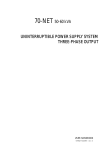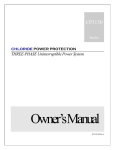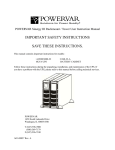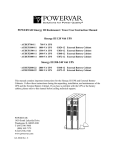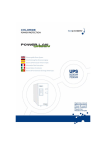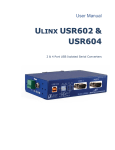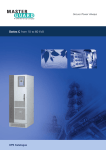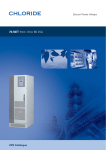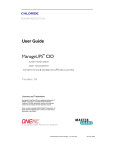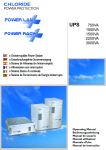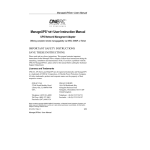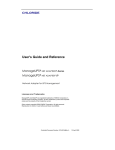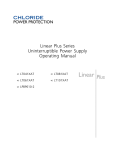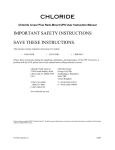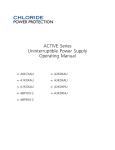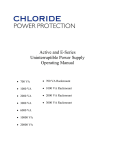Download Chloride CP3150 Series Specifications
Transcript
CP3000 Series CHLORIDE THREE-PHASE Uninterruptible Power System Owner’sManual P/N 913-537 REV D User and Operating Manual CHLORIDE 27944 N. Bradley Rd. • Libertyville • IL • 60048 Toll Free Phone 800-239-2257 • Toll Free Fax 800-833-6829 Phone 847-990-3228 • Fax 847-968-2130 EMERGENCY SERVICE phone 800-388-4234 ii DECLARATION OF CONFORMITY The manufacturer: CHLORIDE Head office at: 27944 N. Bradley Rd. Libertyville, IL 60048 USA HEREBY DECLARES THAT THE PRODUCT: CP3000 CONFORMS TO THE FOLLOWING REGULATIONS: UL1778 FCC PART 15 iii IMPORTANT SAFETY INSTRUCTIONS SAVE THESE INSTRUCTIONS THIS MANUAL CONTAINS IMPORTANT INSTRUCTIONS FOR THE CP3000 SERIES THAT SHOULD BE FOLLOWED DURING INSTALLATION AND MAINTANANCE OF THE UPS, BATTERIES, OPTIONS AND ACCESSERIES iv Table of Contents INTRODUCTION Declaration of conformity iii Safety vii Grounding the unit viii FCC compliance xi CHAPTER 1 DELIVERY AND STORAGE Delivery 1 Unpacking 1 Handling 2 Storage 3 CHAPTER 2 PREPERATIONS FOR INSTALLATION Environmental Conditions 4 Access area 5 Floor loading 6 CHAPTER 3 INSTALLATION Installation data 7 Specifications 8 Suggested cable sizes 9 Terminations 10 Protection devices 11 Electrical connections 12 v Chapter 4 BATTERY Battery connections 16 Chapter 5 OPERATION Display panel 20 Indicators and buttons 21 Menu Structure 23 Menus 24 Warnings and Faults 29 Maintenance by-pass switch and power control unit breaker 30 Operating modes 31 Operational procedures 32 Chapter 6 COMMUNICATIONS Interface slots 33 Communication slot adaptability 34 RAU/RLY/DRV 35 AS400 36 RS232 37 Manage UPSnet 38 LIFE 2000 39 Industrial contacts 40 Chapter 7 MAINTENANCE 41 vi Safety (English) WARNING: This equipment services power from more than one source. The convenience receptacles may have voltage even when the unit is off. UPSs present a different safety issue than most electrical equipment because removing input power from the UPS puts it into backup mode. Removing the input power from the UPS does not remove the electrical charge. To ensure that the UPS is off, turn the inverter OFF before removing the input power from the UPS. CAUTION: Operating this equipment without proper grounding may present a risk of electrical shock. WARNING: Dangerous voltages are present within this unit! There are no user-serviceable parts inside. Any repairs or modifications by the user may result in out-of-warranty repair charges, unsafe electrical conditions, or violation of electrical code. Do not remove the cover. All repairs should be done by qualified service personnel. Voltages inside the UPS may be lethal. Internal components are powered even when the power switch is in the OFF position. Even with the battery disconnected and the unit unplugged, energy is stored in high voltage capacitors and represents a severe shock hazard. Other Safety Considerations: The system is not intended for outdoor use. The operating environment should be maintained within the parameters stated in the manual. Keep the cabinet doors closed and locked to ensure proper cooling airflow and to protect personnel from dangerous voltages inside the unit. The UPS system contains its own power source. Lethal voltages are present even when the UPS is disconnected from utility power. If service or routine maintenance is required: Ensure all power is disconnected before performing installation or service. Ensure the area around the UPS system is clean and uncluttered. Battery maintenance or battery replacement should be performed only by authorized service personnel. Observe all DANGER, CAUTION and WARNING notices affixed to the inside and outside of the equipment. Battery Disposal UPS batteries contain toxic and acidic materials. Disposal method must adhere to local/national recycling laws. Dispose of the battery in one of three ways: ATTENTION: The batteries in this UPS are recyclable. Dispose of the batteries properly. vii CAUTION: DO NOT dispose of batteries in a fire. The battery may explode. Do not open or mutilate the battery or battery cabinet. Released electrolyte is harmful to the skin and eyes and is toxic. WARNING: Only AUTHORIZED SERVICE PERSONNEL should perform maintenance on or service the UPS system. Grounding the Unit CAUTION: Interruption of the protective grounding conductor or disconnection of the protective earth terminal presents a potential shock hazard that could result in personal injury and damage to the equipment. 1) 2) 3) WARNING: An insulated grounding conductor that is identical in size, insulation material, and thickness to the grounded and ungrounded branch circuit conductors except that it is green with or without one or more yellow stripes is to be installed as part of the branch circuit that supplies the unit or system. The grounding conductor supplied in 1) is to be grounded to earth at the service equipment or, if supplied by a separately derived system, at the supply transformer or motor-generator set. The attachment-plug receptacles in the vicinity of the unit or system are all to be of a grounding type, and the grounding conductors serving these receptacles are to be connected to earth ground at the service equipment. viii FCC Compliance ATTENTION: Changes or modifications to this unit not expressly approved by the party responsible or in FCC compliance could void the user’s authority to operate the equipment. This equipment was tested and complies with the limits for a Class A digital device, pursuant to Part 15 of FCC Rules. These limits are designed to provide reasonable protection against harmful interference when the UPS is operating in a commercial environment. The UPS generates, uses, and can radiate radio frequency energy. If installation and use is not in accordance with the instruction manual, it may cause harmful interference to radio communications. ATTENTION: Operation of this equipment in a residential area may cause harmful radio communications interference. The user is responsible for correcting the interference. The basic environmental requirements of the UPS system are: Ambient Temperature Range: 32 – 104°F (0-40°C) Recommended Operating Range: 68 – 77°F (20-25°C) Maximum Relative Humidity: 95% (non-condensing) ix Chapter 1 DELIVERY AND STORAGE DELIVERY The goods have been checked thoroughly before dispatch. Immediately inspect upon receipt of the packaging and ensure that the contents are undamaged. A SHOCKWATCH label has been affixed to the packaging. Red indicator indicates rough handling. If red, Note on Bill of Lading and report immediately to the freight forwarder. UNPACKING Care should be taken when removing the packaging in order to avoid damaging the equipment. Check all packaging materials to ensure that no items are discarded. Remove the packaging following the sequence illustrated in figure 1. Shipping brackets are attached to the UPS or battery cabinets and skid. Remove the brackets by removing the shipping bolts attached to the skid and UPS or battery cabinet/s. REMOVE PACKAGING PACAKAGING PALLET BRACKETS ON BOTH SIDES SHIPPING BOLTS Figure – 1 Shipping and Handling the UPS 1 HANDLING The equipment must be kept upright at all times and handled with care. Damage may be caused if subjected to severe impact. The UPS and battery cabinet has been fitted with casters to allow ease of installation. It is recommended that the UPS and Battery cabinets be moved with a pallet jack or fork lift over long distances. The side skirts have been intentionally left off to allow fork access under the UPS or battery cabinets. See figure 2. Figure – 2 Handling the UPS 2 STORAGE When the UPS is not used within seven days of delivery, please pay special attention to the storage requirements. If the batteries or the equipment is to be stored, they must be kept in a clean, dry environment and away from extremes of temperature. STORAGE DATA Storage temperature range: -4°F (-20°C) to 140°F (60°C); however, batteries should not be exposed to temperature above 77°F (25°C). Each increment of 15°F (8°C) above 77°F (25°C) reduces the expected battery life by 50%. See battery manufacturer’s recommendations. The ideal environmental temperature range is 59° F to 77° F due to the battery life design at 77 F. Each increment of 15 °F above 77 °F reduces the expected battery life by 50%. See battery manufacturer’s recommendations. UPS without batteries -4°F to 140°F (-20°C to 60°C) Relative humidity from 0% to 95% UNLESS BATTERY MANUFACTURER’S SPECIFICATION STATES OTHERWISE 3 Chapter 2 PREPERATIONS FOR INSTALLATION ENVIRONMENTAL CONDITIONS The UPS and battery cabinets must be installed vertically, on a level and even surface. The UPS and battery cabinets must be protected from extremes temperatures, water, humidity, and the presence of conductive powder or dust. Do not stack units and do not place any objects on top of the unit. Although the functional temperature range of the UPS is 32°F to 104°F (0°C to 40°C). The ideal environmental temperature range is 59°F to 77°F (15°C to 25°C) due to the battery life design at 77°F (25°C). Each increment of 15°F above 77°F reduces the expected battery life by 50%. See battery manufacturer’s recommendations. 4 ACCESS AREA The area must have sufficient space for the installation to be carried out. Access doors must be sufficiently large to permit passage of the unit. The UPS has been designed to provide front access for maintenance purposes. See figure 3. TOP ENTRY PLATE TOP FAN EXHAUST 38.6’ 27.6’ 69.0’ FRONT SIDE BOTTOM STATIONARY CASTERS SWIVEL CASTERS Figure – 3 5 BACK FLOOR LOADING It is necessary that the floor in the chosen location be capable of supporting the weight of the UPS and battery cabinets. The weight of these cabinets can be found in table 1. To ease movement over short distances the UPS is fitted with casters. See figure 4. BOTTOM CABLE ENTRY PLATE CASTERS LEVELING BOTTOM Figure – 4 Floor assembly for ease of movement 6 Chapter 3 INSTALLATION Installation must be carried out only by qualified electricians and in conformity with the applicable safety standards. UNLESS MANUFACTURER’S SPECIFICATION STATES OTHERWISE INSTALLATION DATA Ambient temperature 32°F to 104°F (0°C to 40°C) Relative humidity (w/o condensing at 20°C) 0 – 95% Max. Altitude (w/o de-rating) 5000 ft a.s.l. Cable entry top or bottom Air inlet front & bottom Air outlet rear 7 UPS with standard autonomy Table 1 – SPECIFICATONS Unit DESCRIPTION INPUT BY-PASS OUTPUT UPS power rating kVA 10 15 20 kW 8 12 16 Voltage Vrms 208 480 480 208 480 480 208 480 480 Max Current Arms 40 17 17 53 23 23 66 29 29 Frequency Hz Voltage Vrms 208 208 480 208 208 480 208 208 480 Current Arms 28 28 12 42 42 18 56 56 24 Frequency Hz 60 Wave form - SINUSOIDAL 60 Maxi dissipation @ nominal load and battery in recharge BTU/Hr 4443 6118 8150 Battery End-of-Discharge Adc 28 42 55 Mechanical data - Length Inches 38.6 Width Inches 27.6 Height Inches 69.0 Weight (without batteries and input filter) Lbs 850 Weight (with standard autonomy) Lbs 1590 Maximum noise level @ 3 ft dBA 55 For safety, ratings see label. 8 SUGGESTED CABLE SIZES • Input and output conductors are based on NEC 310-16 for insulated copper conductors rated at 75°C in ambient temperature of 104°F. • Grounding conductors are based on NEC 250-95 for copper wire. • UPS input and output cables should be run in separate conduits. • It is recommended that the external cables and protection be selected for the highest possible rating of UPS kVA. • • • Connect the mains supply cables to the UPS input terminals A, B, C, N. Connect the load to UPS output terminals A, B, C, and N. The minimum conductor cross sections apply for maximum currents. Should there be any variation in the conditions it will be necessary to verify whether the cable dimensions satisfy the requirements of NEC. In cases where the cables are so long that they cause a drop in voltage of >3%, a larger dimension shall be selected. For dual input use same cable sizes for single/dual input cables. Table 2 – Recommended cable size Unit Description UPS power rating Kva 10 10 10 15 15 15 20 20 20 I/0 Vac 208/208 480/208 480/480 208/208 480/208 480/480 208/208 480/208 480/480 Max. cable size for terminals Awg 1/0 1/0 1/0 1/0 1/0 1/0 1/0 1/0 1/0 Input phase cable size Awg 8 12 12 6 10 10 4 10 10 Input neutral cable size Awg 6 10 10 4 8 8 2 8 8 Output phase cable size Awg 10 10 14 8 8 12 6 6 10 Output neutral cable size Awg 8 8 10 4 4 8 2 2 8 Earth cable size Awg 6 8 10 4 4 8 2 2 8 The cable sizes are defined as minimum cable sizes. Note: Particularly sensitive equipment may be susceptible to interference, in order to prevent this it is recommended that input, output and any external battery cables to the UPS be housed in earthed, metal conduits. Routing of cables (e.g. power supplies, communication or data lines) to other equipment should be kept separate from that of UPS input and output power cables. 9 TERMINAL CONNECTIONS Table 3 – Recommended terminal connections table TERMINATION TERMINAL WIRE SIZE OF CLAMP TERMINATION TIGHTENING TORQUE lb – in TYPE SCREW INPUT A, B, C #6 – 1/0 50 SLOTTED BY-PASS A, B, C, N #6 – 1/0 50 OUTPUT A, B, C, N #6 – 1/0 50 INTERNAL BATTERY BATTERY (+) (-) #8 – 1/0 45 EXTERNAL BATTERY BATTERY (+) (-) #8 – 1/0 45 CUSTOMER GROUND GROUND #14 – 2/0 45 10 SLOTTED SLOTTED SLOTTED SLOTTED SLOTTED RECOMMENDED PROTECTION DEVICES The following table indicates the protection devices (circuit breakers or fuses), which must be installed by the user for the protection of both the cables and the equipment. For recommended fuses /circuit breakers, see table 4. It is recommended that the protection be selected for the highest rated UPS kVA for future kVA upgrades. Table 4 – Recommended fuses or circuit breakers VOLTAGE PROTECTION DEVICE 10kVA 15kVA 20kVA 208V INPUT Breaker 50 65 80 208V OUTPUT Breaker 35 60 70 480V INPUT Breaker 25 30 40 480V OUTPUT Breaker 20 25 30 11 ELECTRICAL CONNECTIONS In order to gain access to the electrical connections see figure 5, it is necessary to remove the lower right protection panel situated on the front of the UPS figure 2. Cables can be brought in from the top through the access plate and routed through the channels or bottom through an access plate. See figure 3 for the electrical connections. TOP CABLE ENTRY UPS Top Plate REMOVE THE SWITCH HANDLE AND FRONT PANEL TO ACCESS ELECTRICAL CONNECTIONS UPS Bottom Plate BOTTOM CABLE ENTRY Figure – 5 Electrical routing 12 UPS Top Plate (template) 13 UPS Bottom Plate (template) 14 TERMINATIONS Jumpers will be provided between the By-pass and the input connections. These jumpers should be removed if there is a requirement for connection of two separate AC input supplies. Refer to table 2 for correct wire size and table 3 for torque requirements. The BY-PASS is phase rotation sensitive. Clockwise phase rotation is required for this connection. Note: This UPS may be considered a separately derived source. A jumper will be provided and connected between ground and the neutral terminations. Therefore, in this configuration an input neutral will not be required. If there is a question concerning this option, please contact Chloride technical support. 1. Connect the ground wire to the protected earth. 2. For single input connect the AC wires to the INPUT A, B, C, and N. (with jumpers) 3. For dual input connect the MAIN AC wires to the INPUT A,B,C, and BY-PASS AC wires to BY-PASS A, B ,C, and N (remove jumpers) 4. Connect the output AC wires to the output A,B,C, and N 5. 6. If an external battery cabinet is used, connect the positive battery wires to the (+) terminal (1) of the EXT BATT fused disconnect and the negative battery wire to the (-) terminal (3) on the EXT BATT fused disconnect. Connect the external battery cabinet ground to the equipment ground. Figure – 6 Electrical Connections 2 Remove jumper wires for dual input. 3 4 5 1 15 Chapter 4 BATTERY BATTERY CONNECTIONS Connections must be carried out only by qualified electricians and in conformity with the applicable safety standards. The batteries have been pre-wired on each shelf. The battery tray interconnects should only be connected by a factory trained and authorized service representative. As seen in figure 7, the standard battery configurations consist of batteries located in the front lower-left section of the UPS. Optional extended run-times can be purchased or added. Figure – 7 Note: If an external battery cabinet is purchased, it is recommended that this battery cabinet be located adjacent to the UPS cabinet. This external battery cabinet comes complete with protection devices and correctly sized cables. When batteries are sourced from other suppliers, it is recommended that table 2 is used for correct sizing of protection devices and interconnection cables. Please see conduit plate template for proper cutout sizing for cable entry. 16 Optional Battery Cabinet The battery runtime can be increased by employing either one or two optional battery cabinet. Both the UPS and battery cabinet are similar in appearance; however, there is no display panel in the battery cabinet Figure - 8 HCAB 17 Figure- 9 GCAB 18 Battery Cabinet Conduit Plate (Template) 19 Chapter 5 OPERATION DISPLAY PANEL The control panel serves as the UPS user interface. LED’s (Light Emitting Diode) inform the user about three operating parameters of the UPS, LED 1, 2 & 3. The LCD (Liquid Crystal Display) will provide detail on messages, alarms, values and operating conditions of the UPS. 8 13 3 6 2 7 1 5 4 9 12 Figure – 10 20 11 10 INDICATORS AND BUTTONS 1 ON BATTERY - when this LED is illuminated, the battery supplies the inverter 2 ON BY-PASS - When this LED is illuminated, the load is supplied by the By-pass AC power 3 SUMMARY ALARM - When this LED is solid, the UPS is operating with a fault condition. When blinking, it indicates a warning condition. INVERTER ON/OFF - When this button is pushed, the Inverter is turned either on or off 4 5 ENTER - This button allows access to menus on the LCD 6 ESCAPE - This button escapes from any menu on the LCD 21 7 8 9 CANCEL AUDIBLE ALARM - This button silences current alarm EQUIPMENT POWER OFF - This button turns off the entire UPS in 0 seconds. LEFT ARROW - This button allows the user to scroll left on the LCD 10 RIGHT ARROW - This button allows the user to scroll right on the LCD 11 DOWN ARROW - This button allows the user to scroll down on the LCD 12 13 UP ARROW - This button allows the user to scroll up on the LCD LCD Screen – Shows graphical and functional parameters 22 Menu Structure 23 MENUS 1 MAIN MENU The Main Menu screen’s function is to provide the user the selection options for viewing information about the UPS. This is the highest level for menu selectibility. To return to previous screen, press ESC button. Press the ENTER button to select screen. Use the UP and DOWN arrows to toggle through current screen. Actual Values Alarm Information Display Settings About ... 2 ACTUAL VALUES The Actual Values screen’s function is to allow access to various parameters at different locations of the UPS. (shown for By-pass input) By-pass Input UPS Output Battery DC Bus Press to select 3 BY-PASS INPUT The By-pass Input screen displays parameters regarding the Bypass input. Parameters displayed are: Voltage L1, Voltage L2, Voltage L3, and Frequency. Press down or up arrows to view other entries. Press ESC to exit. Voltage L1 Voltage L2 4 ACTUAL VALUES The Actual Values screen’s function is to allow access to various parameters at different locations of the UPS. (shown for UPS Output) By-pass Input UPS Output Battery DC Bus Press to select 24 5 UPS OUTPUT The UPS Output screen displays parameters regarding the UPS output. Parameters displayed are: Voltage L1, Voltage L2, Voltage L3, Current L1, Current L2, Current L3, Frequency, Total Real Power, Real Power. L1, Real Power L2, Real Power L3, Total App. Power, App. Power L1, App. Power L2, App. Power L3 . Press down or up arrows to view other entries. Press ESC to exit. Voltage L1 Voltage L2 ACTUAL VALUES 6 The Actual Values screen’s function is to allow access to various parameters at different locations of the UPS. (shown for Battery) By-pass Input UPS Output Battery DC Bus Press to select 7 BATTERY The Battery screen displays parameters regarding the inverter’s DC bus. Parameters displayed are: cell voltage, current, residual capacity, expected run time, and temperature ᑻC. Press down or up arrows to view other entries. Press ESC to exit. Cell Voltage Current 8 ACTUAL VALUES The Actual Values screen’s function is to allow access to various parameters at different locations of the UPS. (shown for DC Bus) By-pass Input UPS Output Battery DC Bus Press to select 25 9 DC BUS The DC Bus screen displays parameters regarding the inverter’s DC bus. Parameters displayed are: Voltage Total, Voltage +, and Voltage -. Press down or up arrows to view other entries. Press ESC to exit. Voltage Total Voltage + 10 MAIN MENU The Main Menu screen’s function is to provide the user the selection options for viewing information about the UPS. This is the highest level for menu selectibility. To return to previous screen, press ESC button. Press the ENTER button to select screen. Use the UP and DOWN arrows to toggle through current screen. (Shown for alarm information) Actual Values Alarm Information Display Settings About ... Press to select ALARM INFORMATION 11 The Alarm Information screen displays parameters regarding the alarms. (Shown for No for No Faults for No Warnings) To return to previous screen, press ESC button. No Faults ... No Warnings ... OR - ALARM INFORMATION Message 1 of 3 12 The Alarm Information screen is showing message 1 of 3 and specific information on alarm. Using the cursor will show any additional active alarm messages. To return to previous screen, press ESC button. By-pass Mains Failure 26 13 MAIN MENU The Main Menu screen’s function is to provide the user the selection options for viewing information about the UPS. This is the highest level for menu selectibility. To return to previous screen, press ESC button. Press the ENTER button to select screen. Use the UP and DOWN arrows to toggle through current screen. (Shown for display settings) Actual Values Alarm Information Display Settings About ... Press to select 14 DISPLAY SETTINGS The Display Settings screen displays a sub menu regarding the display. Sub menus displayed are: Language and Contrast. (Shown for Language sub menu.) To return to previous screen, press ESC button. Language Contrast Press to select 15 LANGUAGE The Language screen will display a selection of multiple languages in which will change the text of the display LCD to the appropriate language desired. Press Down or UP arrow to desired language. To return to previous screen, press ESC button. English Deutsch Francais Press to select 16 DISPLAY SETTINGS The Display Settings screen displays sub menus regarding display settings. The display sub menus displayed are: Language and Contrast. To return to previous screen, press ESC button. (Shown for the contrast sub menu) Language Contrast Press to select 27 CONTRAST Press 17 The Contrast screen is used to adjust the contrast of the display for ease of readability. Use the left and right arrow to adjust the contrast of the screen. To return to previous screen, press ESC button. (Shown for the contrast sub menu) to select 18 MAIN MENU The Main Menu screen’s function is to provide the user the selection options for viewing information about the UPS. This is the highest level for menu selectibility. To return to previous screen, press ESC button. Press the ENTER button to select screen. Use the UP and DOWN arrows to toggle through current screen. (shown for About sub menu) Actual Values Alarm Information Display Settings About ... Press to select 19 ABOUT Version 1.0 Chloride Power Protection The About screen shows software revision, manufacturer and support information including the hotline. To return to previous screen, press ESC button. Tel: 1-800-388-4234 Press to select 28 TABLE OF WARNINGS AND FAULTS Warnings Over-temperature inverter By-pass mains failure Rectifier mains failure Load too high (2-superscript) Under-voltage intermediate circuit Overload Phase sequence incorrect in By-pass Service By-pass is on Battery operation Battery rest time exceeded Battery under-voltage Commissioning or test mode initiated Battery switch not engaged Ventilator lifetime exceeded Connection to charger lost Faults Temperature in converter too high Internal fault Illegal status of actual values during parallel operation Incorrect power class configuration Inverter contactor defective Multiple inverter cut off as a result of over current Failure power supply electronics Over-voltage in the intermediate circuit External Quick shutdown active Electronics defective (signal processor defective) Defect in the power electronics (rectifier) Defect in the power electronics (UCE-supervision) Over current cutoff False parameter input during H/W init. UPS output out of tolerance Output overload (2)-superscript By-pass defective By-pass defective (during transfer) By-pass overload Electronics defective (EEPROM Inverter) Electronics defective (checksum EEPROM) Environment temperature smaller then 0 degrees or measurement defective Optional module failed or not put in Parallel By-pass failed Signal fault in the parallel module Battery thyristor failure Reserved for the LED test (no fault) 29 MAINTENANCE BY-PASS SWITCH AND POWER CONTROL UNIT BREAKER The maintenance By-pass switch SW1 and the power control unit breaker CB1 are located on the inside lower front-right panel. Figure – 11 Power Control Panel 30 OPERATING MODES The UPS has four different Operating Modes: On-line Operation The UPS normally operates in this mode. The loads are supplied by the mains through the inverter. The batteries are charged by the battery charger as necessary. The Inverter filters mains interruptions, disturbances and provides a stable, interference-free supply to the load. The summary alarm LED on the control panel is not illuminated in this mode. If a mains failure occurs while in On-line operation, the UPS switches to Battery Operation. The On Battery and Summary Alarm LED are illuminated. If an overload condition occurs at the output, the UPS switches to By-pass operation, if available. Battery Operation In the event of a mains power failure the load is automatically transferred to the batteries, without interruption. In this mode, the load is supplied entirely by the batteries, via the inverter. If the power fails, the UPS indicates a fault condition. In Battery operation the On Battery and Summary Alarm LEDs on the control panel are illuminated. The UPS returns automatically to On-Line operation once the mains supply has been restored. Within the battery autonomy period, the UPS provides information regarding the remaining battery autonomy via the Liquid Crystal Display. Static By-pass Operation In this mode, the load is supplied by the mains, via the static By-pass. The static By-pass further ensures the supply to the load; if an overload condition occurs at the output it is automatically activated in order to ensure that there is no interruption in the load supply. In By-pass operation, the on By-pass LED and Summary alarm LED on the front panel is illuminated. The UPS returns to online operation automatically once the fault has been corrected. This will happen only if it is electronically switched and not if the inverter is turned off. Maintenance By-pass Operation Assuming that CB1, F1, and F2 are off and SW1 is in position 3, the load is supplied directly by the mains supply. The Service By-pass is used to supply the load during maintenance operations. In this mode the Service By-pass Switch could be set to either 2 or 3, depending on whether it is required that the BYPASS components remain live or not. Position 3 will allow all components to be de-energized except for power transformers. SW1 The maintenance By-pass switch SW1 is necessary for maintenance work and commissioning. The supply to the load is not interrupted during switching. The switch is shipped in position 3, which allows the load to be feed directly by the utility power. (NOTE: The loads will be energized from the mains through the By-pass switch when the By-pass input feeder supply is energized.) In switch position 3, CB1 on and F1 and F2 disconnected, the UPS is in “Maintenance By-pass” mode. This enables maintenance work to be carried out on the UPS. In switch position 2 and CB1 off, the UPS is in “Maintenance By-pass” mode and the STS components are live. The loads are supplied directly from the mains through the By-pass Switch. This switch setting is designed to test some STS operations without interrupting supply to the loads. In switch position 2 and CB1 “ON”, the UPS is full operational but the output is still in By-pass. This switch setting is designed to test the power control and static switch before putting in service. In switch position 1 and CB1 off, the UPS is in “Static By-pass Mode”. The loads are supplied directly from the mains through a static switch. CB1 The power control unit breaker CB1 is used to supply and when necessary interrupt the power to the control unit. (Note: if the UPS inverter is on, turning off CB1 will switch to battery operation and not shutdown.) 31 OPERATIONAL PROCEEDURES STARTUP PROCEDURE 1. 2. 3. 4. 5. 6. 7. 8. With main disconnect off, switch SW1 to position 3 and CB1 off. Turn main disconnect on. (Supplies load) Turn CB1 on. Close F1 and F2. Turn SW1 to position 2. Check for fault codes. Press interlock pin and turn SW1 to position 1. Press the “INVERTER ON” button for 3 seconds on the front panel. TRANSFER TO MAINTENANCE BY-PASS PROCEDURE 1. 2. 3. 4. Press “INVERTER OFF” for 3 seconds or until the audible alarm is heard and Inverter mimic shows off. Switch SW1 to position 2 and then to position 3. Turn off CB1. Open F1 and F2. TRANSFER FROM MAINTENANCE BY-PASS PROCEDURE 1. 2. 3. 4. 5. 6. Turn CB1 on. Close F1 and F2. Turn SW1 to position 2. Check for fault codes. Press interlock pin and turn SW1 to position 1. Press the “INVERTER ON” button for 3 seconds on the front panel. SHUTDOWN PROCEDURE 1. 2. 3. 4. 5. Press “INVERTER OFF” for 3 seconds or until the audible alarm is heard and Inverter mimic shows off. Switch SW1 to position 2 and then to position 3. Turn off CB1. Open F1 and F2. Turn off main disconnect (and By-Pass disconnect, if required). 32 Chapter 6 COMMUNICATIONS Installation of communication card(s) The CP3000 series can be equipped with a variety of interfacing. Five interface slots have been designed to allow installation of the AS400 card, LIFE 2000 card, R.A.U. card (Remote Alarm Unit), RS232 card and Manage UPS Net adapter card. These interface slots are located behind the front panel in the upper right hand corner. See figure 12. Figure –12 Interface Slots 33 Recommended Communication configuration The following table 5 describes in which different functions of each slot are compatible to the corresponding card types for the Chloride UPS system. These interface slots are located behind the front panel in the upper right hand corner. See figure 5. ManageUPS Net MopUPS Life 2000 AS400 RAU Card/RLY/DVR Slot 4 Slot 5 RS-232 (1) Slot 1 RS-232 (1) Slot 2 RS-232 (2) Slot 3 Preferred position Optional position Table 5 Communication Card Adaptability 34 RAU/RLY/DVR CARD This card allows connection to the Remote Alarm Unit option. It also can be used to drive the Industrial Contact Card as seen in figure 18. The contacts are rated at 30V .5A max. Figure - 13 RAU (Remote Alarm Unit) Card, Relay Card or Driver Card 35 AS400 CARD The AS400 (Relay) card is equipped with a “D”-type female 9-pin connector comprising voltage-free contacts and conforming to the requirements of IBM AS/400 and other computing systems. Figure - 14 AS400 (Relay) card. The interface communication pin layout is as follows • Pin 1 is Bypass • Pin 2 is Summary Alarm • Pin 3 is Shutdown (+) • Pin 4 is Shutdown (-) • Pin 5 is the common for all contact on internal relays. • Pin 6 is Low Battery (N/C) • Pin 7 is Low Battery (N/O) • Pin 8 is AC Fail (N/C) • Pin 9 is AC Fail (N/O) 36 RS232 CARD The male 9-pos. SUB-D connector contains the RS 232 signals. Figure - 15 RS232 Card The interface COM is galvanically separated from all power circuits. • • • Pin 5 GND This connection point serves as a reference for all signals. Pin 2 RXD Standard configuration of an RS 232 interface. Pin 3 TXD Standard configuration of an RS 232 interface. 37 ManageUPSNET CARD ManageUPSNET (formerly known as the SNMP adapter) includes a complete package allowing CP3000 SERIES to be monitored and controlled over a network using TCP/IP protocol. The adapter allows: UPS monitoring from an NMS station using SNMP UPS monitoring from a pc using a Web Browser SHUTDOWN AND MONITORING SOFTWARE The primary function of MopUPSPROFESSIONAL for Windows is to shut down the operating system of an unattended computer, safely, in the event of a power failure. All files are closed and directory pointers are written to disk while the system is supplied from UPS battery power. MopUPSPROFESSIONAL for Windows provides this function and offers other features, useful to network administrators, including: -Automated responses to a variety of events – email, messaging, paging, running script files, etc. -Logging of various events and UPS status information to files -Real time viewing of site power and UPS status information -Administrative shutdown for scheduling planned system shutdowns -Control of UPS performance features - set restart to manual, silence alarms. -Remote access and monitoring of UPS connected to remote servers on the network using Named Pipes or TCP/IP -Notification of events via email Figure - 16 Manage UPS Net Adapter 38 LIFE2000 CARD This option provides remote monitoring of the UPS, via a dedicated telephone line, to ensure maximum reliability for the duration of its operational life. The UPS automatically telephones the service centre at predefined intervals, to provide detailed information, which is analyzed in order to predict any short-term failures. In addition it is possible to control the UPS remotely. Transmission of UPS data to the CHLORIDE service centre is by modem and can be: ROUTINE: typically once a week EMERGENCY: when something goes wrong or when parameters are out of tolerance. MANUAL: when requested by the Customer BIDIRECTIONAL: when requested by the service centre During the calls, the service centre shall: Identify the connected UPS Recognize the kind of call Request the data stored in the UPS since the previous connection Request information from the UPS on line (selectable). The storage of the data, and their subsequent analysis, permits the service engineer to compile a detailed report that will be forwarded to the Customer periodically, with the aim of informing her/him of the condition of the UPS and of preventing potentially critical situations Figure – 17 LIFE 2000 Card 39 .INDUSTRIAL CONTACT CARD Figure - 18 Industrial Contact Card and Bracket The contacts are rated at 120V, 2A. 40 Chapter 7 MAINTENANCE The UPS only requires that the air filters be cleaned on periodical bases and that the area around the UPS is clean and free from dust and debris. When the batteries expire, these must be replaced by the appropriate battery specifications. Exhausted accumulator batteries are classified as “harmful toxic waste” and as such, the law demands that they be disposed of by an authorized recycling center. The CHLORIDE Customer service center is fully equipped to deal with such batteries, in accordance with the Law and with the greatest respect for the environment. The typical battery life cycle is 3 to 5 years, at an ambient temperature of 77 F, but is also dependent on the frequency and duration of mains failures. The BATTERY TEST should be carried out periodically (6 to 12 months) in order to ascertain the general condition of the batteries. MAINTENANCE: Although there is no requirement to substitute UPS internal components regularly as a preventive measure , depending on environmental conditions specific components more subject to aging (e.g. electrolytic capacitors, backup batteries, fans etc.) may require replacement on an occasional basis. Therefore, CHLORIDE recommends that regular maintenance checks be carried out on site by a CHLORIDE authorized service engineer. Annual maintenance is normally sufficient for most applications. For harsher environments (ambient temperatures above 77 degrees, high concentration of dust & debris etc.) the periodicity should be adjusted, The UPS indicates when the end of a fan’s lifetime has expired. When this indication is present replacement of all fans is recommended. The typical battery life cycle is 3 to 5 years, at an ambient temperature of 77 F, but is also dependent on the frequency and duration of mains failures. The BATTERY TEST should be carried out periodically (6 to 12 months) in order to ascertain the general condition of the batteries. CHLORIDE recommends individual battery testing by a CHLORIDE authorized service technician on a Semi-Annual basis. When the useful lifetime of the batteries has expired, they must be replaced by an authorized CHLORIDE service technician. Exhausted batteries are classified as “harmful toxic waste” and as such, must be disposed of in accordance with the applicable regulations. CHLORIDE’s authorized service technicians are fully equipped to deal with such batteries in accordance with regulations and with the greatest respect for the environment. 41 PRECAUTIONS During maintenance, disconnect the battery blocks so that no more than five batteries are connected in series. (NOTE: This cannot be achieved with internal batteries) All safety and handling instructions shall be carefully observed. Qualified personnel may only remove the access panels. Watches rings and any other metal objects must be removed before working on the batteries Rubber gloves must be used. Insulated tools only must be used. An insulated mat must be placed in front of the battery cabinet before any operation is carried out thereon. Never work alone. Ensure the presence of a person able to give assistance in case of accident. STORAGE For extended storage at ambient temperature, < 77°F the batteries should be charged for 5 hours once every 4 months; at higher storage temperatures, it is advised that this period be reduced to two months. Make sure the Power Control Unit Breaker is in the OFF position before continuing. Follow the electrical installation procedure in Chapter 3. Connect the positive and negative External Battery Cabinet Connections if purchased. See chapter 4 for battery information. Switch the Power Control Unit Circuit Breaker (CB1) from OFF to ON. After 5 hours, turn OFF the Power Control Unit. For external cabinets, charge for a minimum of 12 hours per battery cabinet. Then remove the UPS connections in the opposite sequence described in Chapter 3. Note the date recharging was carried out in the vicinity of the UPS or on its packaging. CLEANING Switch off the UPS by pressing the OFF button and disconnect from the mains supply. (See shutdown procedure on page 26) Do not use scouring powder or plastic-dissolving solutions to clean the UPS. Do not allow liquid to get inside the UPS. Make sure that the air vents on the UPS are not obstructed. Clean air filters as necessary. Clean the outside of the UPS housing by wiping with a dry or a slightly damp cloth. 42 For a number of years CHLORIDE has been committed to a policy of Total Quality and today devotes a great deal of resources and energy to providing the best possible after-sales service. Therefore, we value any suggestion you might make and consider it an inspiration for our continued improvement. We thank you in advance for any such suggestions that may be forwarded to the addresses listed in the last page. This document is for information only. It is the policy of this company that its products are continually improved therefore CHLORIDE reserves the right to alter any or all of the information contained herein without prior notice. CHLORIDE www.chlorideups.com 43




















































